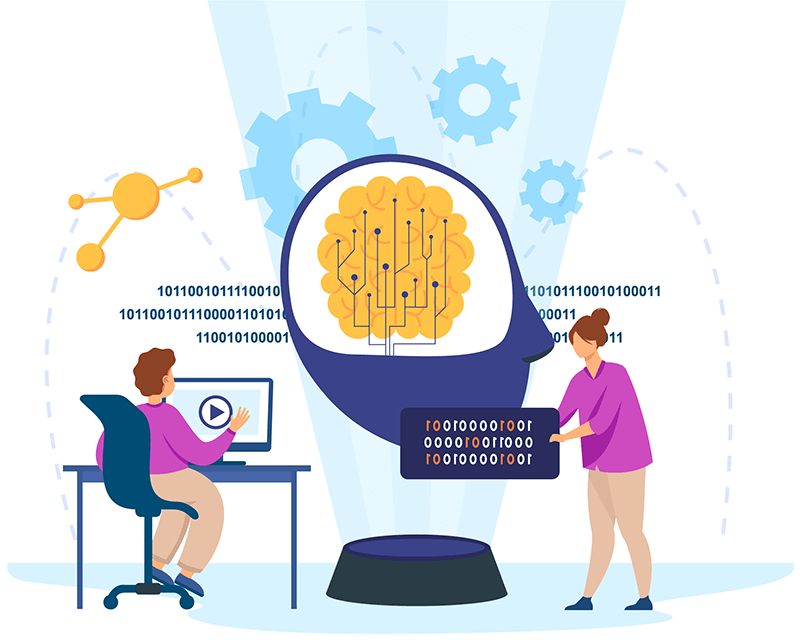
Machine Learning is like conducting a grand experiment – the essence of this captivating field. These experiments propel our journey forward, yet we must realize that not all trials hold the same significance. While some may lead to substantial business impacts, others might fall short. What’s genuinely puzzling, however, is that skillfully selecting the right experiments, orchestrating them effectively, and refining them for maximum impact is often left unexplored in the confines of standard Machine Learning education.
This gap in understanding frequently results in bewilderment. For those just stepping into the world of Machine Learning, there’s a risk of assuming that problem-solving involves recklessly tossing all potential solutions into the mix, crossing fingers for a stroke of luck. But rest assured, that’s galaxies away from reality.
To be clear, we’re not delving into the intricacies of offline and online testing or the expansive realm of A/B testing with all its diverse iterations. Instead, we’re immersing in the process that occurs before and after the actual experiment takes place. Questions arise: How can we astutely determine which paths are worth exploring? What’s the game plan when experiment outcomes fall disappointingly flat? How can we optimize our approach with the utmost efficiency?
In broader strokes, let’s ask the bigger question – how can you distill the maximum essence from your Machine Learning experiments? Here, within your grasp, lie five uncomplicated strategies poised for adoption:
Step 1: Choose your experiments wisely
Hey there, fellow ML enthusiast! Have you ever felt the whirlwind of questions spinning in your mind? Should we toss out that feature? Maybe throw in an extra neural network layer? Or what if we give that supposedly turbocharged library a shot? Trust me, we’ve all been there, and the possibilities are as endless as your curiosity.
But here’s the trick: your time is precious, and your budget is a bit tight. So, how do you figure out where to focus your experimenting mojo? Let’s break it down with some down-to-earth advice:
First things first: Channel your inner detective. Take a breather and get cozy with your current model. Peek into its nooks and crannies to spot the gaps. Where’s it struggling the most? Those gaps are your golden nuggets – your best bets for experimenting.
Feature or fancy: Think about what makes your model tick. If it’s living the simple life with just a few features, your experiments should dance around feature discovery. On the other hand, if it’s a chill logistic regression model, tweaking the model’s architecture might be where the magic happens.
Skip the obvious: Imagine this – you’re about to leap into the experiment-o-sphere, but wait! Have you done your homework? If the research crowd is already nodding in agreement about a question you’re itching to explore, you might not need to reinvent the wheel. Trust the research unless you’ve got some heavyweight reasons to think otherwise.
Mission clarity, ASAP: Clear the mist before you step into the experiment arena. What’s success supposed to look like? Nail down those success criteria before you begin because if you’re unsure what success is, how will you even know when you hit it? I’ve witnessed models stuck in limbo because the finish line kept moving. Don’t be that model – define your victory dance before the show starts.
So, my experiment-loving friend, remember this roadmap as you dive into the sea of possibilities: choose bright, learn from what’s known, and define success before you leap. Happy experimenting!
Step 2: Begin with a bold hypothesis
Alright, it’s time to put on your scientific thinking cap! Like in a lab, where experiments start with hypotheses, your Machine Learning journey should kick off with a crystal-clear hunch. We’re talking hypothesis town, where you speculate before you speculate some more. Let’s dive in:
The hypothesis drama: Imagine yourself in a science movie. First, you whip out a statement – your hypothesis – and it often comes with a cheeky “because.” It’s not a question, mind you. Something like, “I bet a BERT model rock for this gig because words are all about context, not just word counts.”
Not just guesswork: Your hypothesis should be like a superhero origin story – a statement of intent! Maybe you’re convinced a neural net outshines logistic regression because the way features mingle with the target is like a tango, all non-linear and fancy. Or perhaps you’ve got this feeling that tossing in extra features could jazz up your model’s game, like seasoning in a dish.
HARKing? Not cool: Have you ever seen those humongous results spreadsheets that look like a data tornado hit them? Yep, they can be as clear as mud. And when someone asks, “Hey, why’s this number dancing with that number?” the answer might be a shrug and a wild guess. HARKing, they call it – guessing after peaking at results.
Science vs. pseudo-science: HARKing? It’s more like “harking up the wrong tree.” It’s the opposite of science – it’s like a magician revealing their tricks before the show even starts. And trust me, that’s not good. It can lead to fake results that sound fancy but are just the cosmic toss of a coin.
Are you guarding against flukes: The secret weapon? Hypothesize before you experiment. It’s like putting on your armor against fluke discoveries. Predict before you peek, and you’re steering clear of the rabbit hole of chance.
So, our savvy hypothesis builder, as you embark on your Machine Learning quest, remember this: hypothesis first, results later. It’s your secret sauce to cooking up real, not random, insights.
Step 3: Craft crisp feedback loops
Buckle up – we’re about to supercharge your experimentation game! Imagine this: tweaking something in your Machine Learning setup is as breezy as adjusting a single line of code and hitting the “go” button. If it’s more like a complex tap dance, let’s reel it in. Get ready for snappy, streamlined feedback loops that won’t have you jumping through hoops. Let’s dive in:
Simplify naming with magic: Time wasted on brainstorming nifty names (think “BERT_lr0p05_batchsize64_morefeatures_bugfix_v2”) is time you’re not spending experimenting. Instead of cracking your head over it, automate the naming game with excellent libraries like “cool name.” Toss the parameters into log files – quick and painless.
Log like you mean it: Be generous with those logs. When jotting down your experimental setups, go a bit wild. Logs are like candy – they’re cheap and always welcome. Because here’s the kicker: re-running experiments just because you can’t remember which knobs you twisted is like throwing time and energy down a black hole.
Notebooks, not so much: Notebooks can be like that moody artist friend – tricky to share, version, and oh, they’re notorious for mixing code with logs. In the world of ML experimentation, scripts often take the cake. They’re version-able, shareable, and keep a neat line between code and logs. Think of them as the organization gurus of experimentation.
Baby steps and swift falls: Here’s a nifty trick – first, run your experiments on a compact, bite-sized dataset. It’s like dipping your toes before the full plunge. You get swift feedback without losing precious time. If your idea isn’t vibing, you’ll know it in a heartbeat – and that’s the beauty of “failing fast.”
One change, one world: You’ve got a bunch of changes in mind? Hold up! Making a million changes in one go is like juggling blindfolded. Keep your sanity intact by introducing just one tweak at a time. It’s your compass to decipher which tweak led to that dance in your model’s performance.
So, brave experimenter, gear up for these game-changers: snappy names, abundant logs, sleek scripts, cautious starts, and single tweaks. Your journey just got smoother and faster. Happy experimenting!
Step 4: Steer clear of the "Shiny New Thing" trap
Hold onto your excitement hats – we’re diving into a trap that’s snared many an eager explorer! So, there’s this all-too-common scene: folks getting starry-eyed over the latest and greatest ML research paper convinced it’s their golden ticket. But here’s the twist: what works in pristine research isn’t always the magic potion for our practical ML world. Buckle up because we’re about to decode this phenomenon:
Reality check, please: Have you ever noticed how research problems and real-world challenges are like cousins, not twins? What sparkles in academia might not quite have the same allure in the nitty-gritty world of ML production.
Tricky riddles vs. business basics: Take those grand language models like BERT. They sent ripples through academia, acing intricate linguistic puzzles like “The trophy did not fit into the suitcase because it was too small. What was too small, the trophy or the suitcase?” But guess what? Your everyday business problem might involve identifying battery-laden products in an e-commerce catalog. Suddenly, that fancy linguistic wizardry might be overkill.
The antidote: Fear not, there’s a cure for this “shiny new thing” fever. It’s none other than the suitable old scientific method. Have you got a hunch? Formulate it into a clear hypothesis before you hit the experiment button.
“New” isn’t a hypothesis: Brace yourself because simply saying, “It’s a new model!” doesn’t cut it. You must dig deeper, foresee outcomes, and craft a thoughtful statement of intent.
So, here’s the bottom line: resist the allure of shiny novelties. Instead, stick to your hypothesis-hunting guns, and you’ll navigate the sea of trends and innovations with wisdom.
Step 5: Break free from experiment limbo
Hold onto your lab coats – it’s time for the final stretch! Imagine this: your experiments are like puzzle pieces that fit differently. Sometimes, they click with your hypothesis; other times, they don’t. Both outcomes hold a map to treasure. Positive results supercharge your models, while negative ones illuminate where not to venture. But here’s the twist – beware the treacherous swamp called “experiment limbo.” Let’s wade through it together and bring in a bit more wisdom:
The limbo tangle: Have you ever seen a fellow experimenter caught in this loop? They test a hypothesis, and it falls flat. Instead of picking up the pieces and moving forward, they tumble into the same rabbit hole, tinkering endlessly, perhaps under sunk costs or organizational pressure.
Embrace the learning curve: Repeat after us – “negative outcomes are stepping stones.” While they might not throw confetti, they certainly guide your journey. Don’t let them hold you hostage. Accept, adapt, and step ahead – that’s how you dance out of the limbo.
But wait, there’s more wisdom to gather:
“Every experiment teaches you something. Don’t just experiment – evolve.”
Embrace this mindset, dear explorer. Every experiment whispers a lesson. The finest minds in Machine Learning have a secret: they’re always hatching experiments, nurturing a pool of hypotheses ready to spring into action. As they’re about to sign off for a break, they unleash a storm of tests. More experiments mean more insights and more expertise.
Wrapping it up this guide
Let these nuggets shine:
Wise timings: Know when to pull the experiment trigger – choose wisely.
Hypothesize the future: The starting block isn’t the experiment; it’s your hypothesis. Avoid the siren call of guesswork.
Agile learning: Loosen the feedback loops for lightning-fast insights.
Dazzling not useful: Shun the sparkle of “shiny new things.” Real-world ML isn’t a replica of academic pursuits.
Farewell, limbo: Escaping experiment limbo sets you free to explore uncharted territories.
Remember, you’re not just experimenting – you’re trailblazing a path to innovation.
💡 Have you heard about the MLOps conceptual framework listing all machine learning operations? Please find here → https://hystax.com/mlops-conceptual-framework-listing-all-machine-learning-operations/




